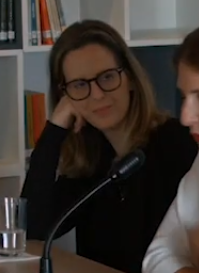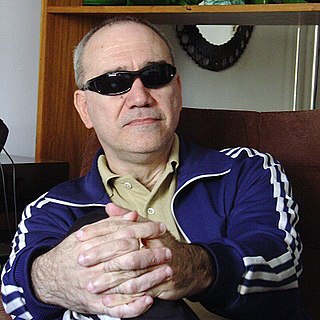TV Colosso was a Brazilian children's television series produced by Rede Globo, that began on April 19, 1993, and finished on January 3, 1997. The show utilized puppets, body puppets, remote-controlled animatronics and bluescreen puppets. It stars a group of working dogs in a TV station that struggle to put her TV shows on air.
Arnaldo Angeli Filho, more commonly known as Angeli, born August 31, 1956 in São Paulo, Brazil, is one of the best-known Brazilian cartoonists.
Horacio's World is a Brazilian comic strip, part of the Monica's Gang comic strips. The main character is Horácio, a baby Tyrannosaurus rex, created in 1961. He debuted as one of the supporting characters of Pitheco's comics in The Cavern Clan, but their solo stories started in 1963. Other minor characters appear occasionally, but Horacio's strips mostly consist of monologues and self-reflections, thus making him Mauricios's alter-ego. Also, all his stories are written by Mauricio himself.

Monica is a Brazilian fictional character and Mauricio de Sousa's best-known creation. Introduced in 1963, she serves as the main protagonist and title character of the Monica's Gang comic book series and media franchise.
Glauco Villas Boas was a Brazilian illustrator, cartoonist and religious leader. He belonged to the Villas-Bôas brothers family.

Carmen Miranda: Bananas is My Business is a 1995 documentary filmed and directed by Helena Solberg. This documentary chronicles the life and career of Carmen Miranda, Hollywood's symbol of Latin American spirit in the 1940s. The documentary tells her life story in a series of stages, beginning with her roots and rise to stardom in her home country of Brazil, her transition and development as a performer in the United States, first on Broadway in New York City, then in the film industry after she signed with 20th Century Fox in Los Angeles, and her later years in life, before her death and her return to Brazil. Helena Solberg uses two different film styles, biography and directorial reverie, in which Solberg uses actor Erick Barretos to “resurrect Carmen Miranda in several fantasy sequences. Helena Solberg's attitudes shift throughout the documentary from awe-struck child to empathetic and forgiving Brazilian woman, which she uses to represent the contradictory subplots of Carmen Miranda's life. Alongside the fantasy like resurrection of Miranda, Solberg accompanies her documentary with multiple interviews with Carmen Miranda's friends and family, like her sister, her first boyfriend, the guitarist Laurindo Almeida, samba song-writer Synval Silva, Cesar Romero, and Alice Faye.
Adão Iturrusgarai is a Brazilian cartoonist and comics artist.

Vanessa Barbara is a Brazilian journalist and author. She is a columnist for the newspaper O Estado de S. Paulo, having also written for the magazine piauí and the newspaper Folha de S. Paulo. Her articles are also featured in the International New York Times.

El Pequeño Mundo is the nineteenth studio album and the fourth in Spanish language album by Brazilian singer and TV host Xuxa Meneghel. It was released in October 1994 in Argentina by Polygram.

Tatiane "Tati" Bernardi Teixeira Pinto is a Brazilian short story writer, novelist, chronicler, screenwriter and journalist. Her works are particularly directed towards young women.

Rafael dos Santos Coutinho is a Brazilian comics artist, painter and animator.

Julia Nascimento Bacellar, known as Julia Bax, is a Brazilian comics artist. Her first comic book work was published in the Brazilian magazine Kaos!, recommended by Roger Cruz. After that, she made the drawings of a 12-page story on the album Quebra-Queixo Technorama Volume 2, published by Devir. By these two works, in 2006 Julia won the Troféu HQ Mix, the main Brazilian comic book prize, in the category "Revelation Penciller". She started working for publishers in other countries, especially Marvel Comics, in which she participated in the magazine X-Men: First Class. Julia also has published works for publishers like Boom! Studios, Devil's Due and Le Lombard, among others. Some of her published works are Histórias, Remy and Pink Daïquiri. In 2016, the Belgian publishing house Le Lombard published the graphic novel Princesse Caraboo, based on the true story of the notorious impostor Mary Baker.

Pedro José Ferreira da Silva, known as Glauco Mattoso, is a poet, writer, novelist, essayist, translator and songwriter from Brazil.

Éramos Seis is a Brazilian telenovela produced and broadcast by Rede Globo. It premiered on 30 September 2019, replacing Órfãos da Terra, and ended on 27 March 2020. It is based on the book of the same name written by Maria José Dupré. The series is adapted by Ângela Chaves, with the collaboration of Bernardo Guilherme, Daisy Chaves and Juliana Peres.
Lúcia Guimarães is a Brazilian journalist. While based largely in New York, she became a frequent contributor to Brazilian television, print, and radio media on the culture of the United States and events in American politics. She has been a columnist at Folha de São Paulo and O Estado de S. Paulo and a producer at Rede Globo, and she contributed to the talk show Manhattan Connection for 16 years.
Hilde Weber was a Brazilian artist, cartoonist, and illustrator of German origin. She was the first female cartoonist in the Brazilian press, working for such publications as A Cigarra, O Cruzeiro, Manchete, and Tribuna da Imprensa, where she became known for her political cartoons.
Antônio de Souza Mendes Neto, better known as Toninho Mendes, was a Brazilian editor. He started working in the 1960s, going through several publishers and alternative newspapers, such as Movimento and Versus. In 1984, Mendes founded Circo Editorial, considered the most important Brazilian publishing house of alternative comics in the 1980s and 1990s. Circo featured artists such as Laerte, Angeli and Glauco, among other important names in the Brazilian underground comics that achieved prominence in the publications published by Mendes. The story of Circo publishing house was told by Mendes himself in the book Humor Paulistano: a experiência da Circo Editorial, 1984-1985, which won the Troféu HQ Mix in 2015 in two categories: "Best Theoretical Book" and "Best Editorial Project". Mendes also won the Troféu HQ Mix in 2011 in "Best Erotic Publication" category for Quadrinhos Sacanas, a collection organized by him which published anonymous erotic comics created between the 1950s and 1980s.









